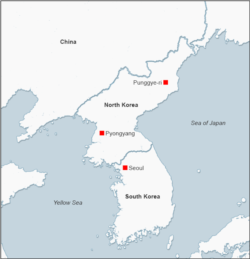Experts say North Korea has not abandoned its Punggye-ri Nuclear Test Facility, with satellite images suggesting Pyongyang has been maintaining the site that was partially sealed by detonations in 2018 before international witnesses.
“All evidence points to the fact that North Korea has not abandoned the site and that the site is in caretaker status,” said Joseph Bermudez, senior fellow for imagery analysis and North Korean defense expert at the Center for Strategic and International Studies (CSIS).
Bermudez said satellite imagery over the past year continues to show activities such as vehicle movements, road maintenance, and a security presence around the site, suggesting Pyongyang has been maintaining the facility.
The last image Bermudez said he examined was from Jan. 16.
Pyongyang demolished tunnels at the nuclear test facility in May 2018 as invited foreign journalists watched the detonation.
According to Frank Pabian, a former nuclear chief inspector for the IAEA and currently a satellite imagery analyst at Center for International Security and Cooperation (CISC) at Stanford University, “The time necessary to reactivate is a few months or less if they reopen the previously unused tunnels. If they were to open a new tunnel, it could take at least a year or more.”
The site and its tunnels were used for underground nuclear tests.
“Blowing up the site’s tunnels, sealing the entrances and removing test site facilities and equipment,” was never irreversible, although it was “a serious step toward denuclearization,” according to a Washington Post op-ed written soon after the detonations by the American metallurgist and nuclear scientist Siegfried S. Hecker.
Activities at the site
The only known nuclear test site in North Korea is drawing renewed attention. Last week, the regime announced it will consider ending a self-imposed moratorium placed on testing its nuclear weapons and long-range ballistic missiles, according to KCNA, the official state news outlet.
North Korea has intensified tension on the Korean Peninsula this month by conducting six missile tests. South Korea’s Joint Chiefs of Staff announced the most recent, a Thursday morning launch, via a text message to reporters, according to Yonhap News Agency in Seoul.
North Korea has not tested its nuclear weapons since 2017, but all of its six nuclear tests conducted between 2006 and 2017 were done at the Punggye-ri facility in North Korea’s northeast.
Experts said while there are no indications that North Korea is trying to reconstruct the facility, it appears to maintain the site to allow for possible future use.
“They’re kind of maintaining the site in such a way that you see trails of cars, cleaning of snow, and things like that, so they’re kind of maintaining the building in some kind of conditions,” said Olli Heinonen, former deputy director-general for safeguards at the International Atomic Energy Agency (IAEA).
“It’s more than just simple monitoring. You don’t need to have this kind of continuous procedure,” he added. “They probably maintain the site so that they [could] make a decision at a later date to do … tests. They might use some tunnels which were not destroyed in 2018.”
Heinonen said that aside from maintaining the site for possible future use, North Korea may be keeping it up to prevent the spread of radioactive material from previous nuclear weapons tests.
The U.S. State Department responded to VOA's Korean Service report on North Korea's continued activities around the site and told the service on Tuesday that the U.S. is "aware of the reports" and committed to the complete denuclearization of the Korean Peninsula and remains open to diplomacy.
Reservations about irreversibility
Experts said North Korea could reactivate the site by repairing the destroyed entrance or building a new one to get to the tunnels that they believe were not completely demolished.
“They claimed to have blown up the inner tunnels, but one wonders if that was really the case,” said David Albright, president of the Institute for Science and International Security (ISIS). “And if only the entrances were blown up, within a few weeks, few months, they certainly could dig back in and have the site up and running.”
Michelle Kae, deputy director of the Stimson Center’s 38 North Program which focuses on North Korea, said, “If the bulk of the test tunnels were left untouched, then the entrances could potentially be re-excavated, especially at the West and South Portals, where tests were never conducted.”
Pabian, of CISC, said that several buildings that were not destroyed suggest Pyongyang could reactivate the site.
“The two main buildings at the Command Center, a two-story Headquarters Building and a one-story building adjacent to it remain intact,” said Pabian in an email to VOA’s Korean Service.
“The fact that these key buildings were never demolished has always suggested that reopening the test site for future additional nuclear testing was one intended … option,” Pabian added.
According to a report by the U.N. Panel of Experts that monitor implementation of U.N. sanctions on North Korea dated August 2020, “two to three months would be sufficient to reconstitute one of the tunnels, reinstall the infrastructure required to support a test.”
The panel’s report dated March 2021 said there is continued “presence of personnel that this site has not been abandoned.”
Bermudez said construction work to reactivate the site “would be visible” by satellite imagery.
At the same time, however, Bermudez said intelligence communities might have a hard time detecting locations for other potential nuclear test sites.
“I’ve looked at every square meter in North Korea in my life, hundreds of mining sites that are active or abandoned, and telling one from another is really challenging,” Bermudez said. “Unless North Korea does an actual test, we won’t know if there are any where those locations are.”
VOA Korean Service reporters Sungwon Baik and Jiha Ham contributed to this report which originated with the service.

